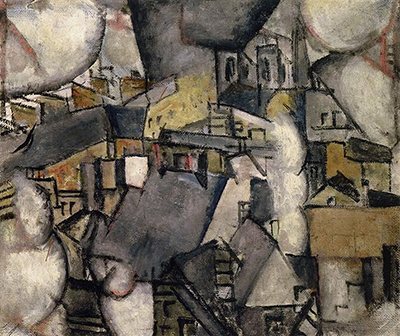Chimneys on Rooftops remains one of the greatest pieces of art produced by Fernand Leger. He created it in 1911 and it belongs to the cityscape genre.
Like many of his other pieces, this one was developed by the machine art style. This kind of development was characterized by using monumental mechanistic forms done in bold colours. The style used in this piece of art is cubism. Back in the 20th century, cubism was an influential visual style of art. It was created by Pablo Picasso in 1907 and George Braque. The art frontiers played a huge role in life Fernand, as an artist. Fernand Léger used oil and canvas to bring out his prowess. The location of the Chimneys on Rooftops remains to be a private location to date. The art depicts a city set up of houses and buildings. Fernand Léger. Like many of the pieces of art done by Fernand Léger, the colours used in the Chimneys on Rooftops are bold making this piece easily recognizable and eye-catching. Its dimensions are 45.7 by 54.6cm.
As mentioned earlier, Fernand Léger was inspired by Pablo Picasso and George Braque. This is evident from his love of the cubism style. Cubist painters rendered radically fragmented items. They were not limited to colour, space, texture and did not use the copying form. Unlike the traditional techniques such as modelling, foreshortening and perspective, the cubist style used a flat two-dimensional surface of a picture plane. Fernand Léger's work was a little bit different from the mainstream cubism. He does not entirely walk away from the three-dimensionality as well as volumetric style. His drawing also indicates some influence from Paul Cezanne. Fernand Léger work shows his consistency in primary colours, bold form, pattern and graphic. He would sometimes, however, use much more sombre colour schemes in order to avoid the viewer becoming distracted by the palette, when actually he wanted them to focus more on the shapes and lines that he had added across the composition.
Fernand Léger was a great influence on the artists of his period and remains one today. He is famously known for his outstanding and unique style. The Frenchman was born in 1881 in Argentan, France. He, later on, moved to Paris to build himself up as an architectural draftsman. His earliest works were greatly influenced by impressionism. Generally, his works were influenced by cubism and modern industrial technology. This article looks at one of his pieces, Chimneys on Rooftops because it is seen by some as being amongst his most important, though, in truth, his oeuvre is very large indeed and also varied, and so it is important to always look beyond just what some term his highlights in order to really get a good grasp of the artist himself. The same can be said for many contemporary artists whose peak is biased towards, to the point where much of their earlier work is almost completely ignored - this can be said for the likes of Piet Mondrian who produced some stunning landscape paintings prior to his push towards the extreme abstractions that appeared later on.




